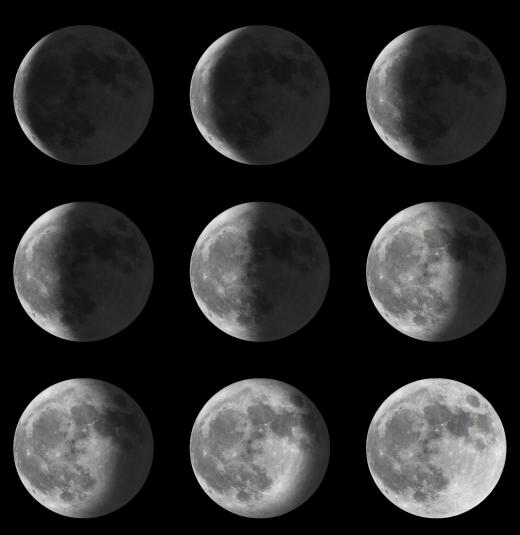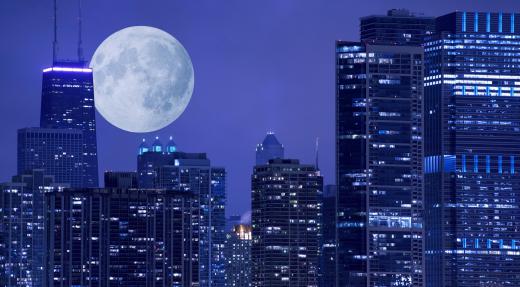What are Lunar Phases?
 Mary McMahon
Mary McMahon
Lunar phases are different stages in the cycle of the moon's orbit around the Earth. As the moon moves, people on Earth see varying levels of its illuminated surface, from a new moon, in which the moon can't be seen at all, to a full moon, in which people see the entire portion of the moon illuminated by the Sun. This cycle takes a little less than 30 days to complete, and it may be known collectively as the lunar cycle.
People have been tracking lunar phases for thousands of years. The obvious waxing and waning of the moon was clearly visible to human societies, and many cultures based their measurements of months around the moon's movements. They also associated particular phases with various events and beliefs. For example, some cultures believed that waning moons were associated with bad outcomes in new endeavors.

The lunar phases are fairly easily explained by astronomy. At any given time, fully half of the moon and half of the Earth are illuminated by sunlight. As the moon orbits around the Earth, varying levels of the illuminated area can be seen by people standing on Earth. When the moon is between the Earth and the Sun, the illuminated side faces away, creating a new moon. Full moons occur in the opposite situation, when the Earth is between the moon and the Sun.

One might expect a constantly cycle of lunar and solar eclipses which would correspond with the lunar phases, except that the orbits of the Earth and moon are angled, rather than occurring along a straight line. This means that the perfect alignment needed for an eclipse is actually fairly rare.
When the moon is growing, it is said to be “waxing,” while a “waning” moon is shrinking. In the Northern Hemisphere, the phases of the moon move from the right to the left side of the moon's surface: if only the right quarter is illuminated, the moon is waxing towards full, while a small sliver of darkness on the right side of the moon indicates that the moon is on the wane. The opposite is true in the Southern Hemisphere, and along the equator, the crescents of waning and waxing moons actually appear in a horizontal alignment.

The variation in the appearance of the lunar phases around the world is explained by the relationship between the angles of the moon, Earth, and Sun. Changes in angle will alter the way people see the moon, depending on where they are. These variations also explain why sunrise and sunset occur at different times.
AS FEATURED ON:
AS FEATURED ON:













Discussion Comments
@Terrificli -- Those dials are neat but they are mostly decorative these days. Think about it. There was a time when you would set one of those and it was a wonderfully useful thing. There were few other ways available to track the moon phases.
Ah, but things have changed. You can check the various lunar phases simply by logging onto the Internet or (in a lot of cases) simply checking the weather app on your phone.
Don't get me wrong. I love those lunar dials built into grandfather clocks. But technology has make them primarily nice to look at rather than actually useful.
My parents have a grandfather clock that has a dial that shows off the phases of the moon (that's not exactly advanced technology because we have been studying those for years). Anyway, that dial was a darn handy thing to have. Set it once and you could tell if the moon was full, waxing, waning or whatever else.
@Soulfox -- The way people see the moon does have to do with angles, but the "closeness" of the moon to the horizon during its various lunar phases is very important, too. If you see the moon almost directly overhead and it appears to be hanging in the middle of the sky, it will looks small. If it is low on the horizon, though, it will look absolutely huge.
Is the moon closer to the earth when it looks big and farther away when it looks small? No, but it appears to be large when it is hovering low in the horizon because you are comparing it to trees and such on the horizon. You don't have those objects to compare the moon with when it is hanging in the sky by itself, so the moon looks small.
So, angles have an impact on the way people see the moon during the various moon phases, huh? Is that why the moon looks absolutely huge at times and very small at others? It makes sense that the angle at which we view the moon would have an impact on how big or small it looks.
Or, could it be that the moon is closer to the earth at some times than others.
Post your comments